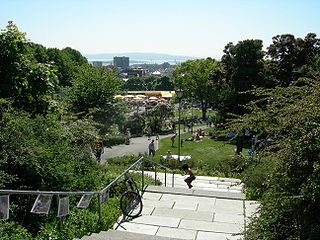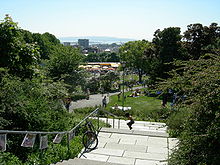
Oslo is the capital and most populous city of Norway. It constitutes both a county and a municipality. The municipality of Oslo had a population of 709,037 in 2022, while the city's greater urban area had a population of 1,064,235 in 2022, and the metropolitan area had an estimated population of 1,546,706 in 2021.

St. Hanshaugen is a borough of the city of Oslo, Norway.

Grünerløkka is a borough but also a neighborhood of the city of Oslo, Norway. Grünerløkka became part of the city of Oslo in 1858. Grünerløkka was traditionally a working class district; since the late 20th century the area has increasingly undergone gentrification. Especially in the core neighborhood of Grünerløkka, property prices tend to be higher than is typical of other Oslo East End boroughs.

Nordre Aker is a borough of the city of Oslo, Norway.

Sentrum, meaning city-centre, is located on the southeast side of Oslo near the inner Oslofjord.

Carl Berners plass is an underground rapid transit station located on the Grorud Line of the Oslo Metro, and a tram stop on the Sinsen Line of the Oslo Tramway. The square also has a bus stop for lines 20, 21, 31 and 33. Located at Helsfyr in Oslo, Norway, the area has a mixture of apartment buildings and small businesses. The station is the first metro station on the Grorud Line after it branches off from the shared Common Tunnel. North of the station, the Ring Line branches off from the Grorud Line. The station is served by line 5 of the metro and Line 17 of the tramway, with four hourly departures during regular hours. The tram operates every 10 minutes during regular hours.

Lilla Georgine Hansen was Norway's first female architect.
Haugen is a Norwegian surname and place name frequently used for farm homesteads. Haugen derives from the old Norse word haugr meaning tiny hill, small grassy knoll, or mound. Derivatives also include the Norwegian surnames Haugan and Hauge.

Birkelunden is a park placed centrally in the Grünerløkka borough of Oslo, Norway. It is formed as a rectangle, more or less like a city block.

The Common Tunnel, sometimes called the Common Line, is a 7.3-kilometer (4.5 mi) long tunnel of the Oslo Metro which runs through the city center of Oslo, Norway. The name derives from the fact that all five lines of the metro use the tunnel, which runs from Majorstuen to Tøyen. The section has six stations, including the four busiest on the metro.

The Sagene Line is a former line of the Oslo Tramway in Norway. It ran from Stortorvet in the city center along Akersgata and Ullevålsveien through the neighborhood of St. Hanshaugen. It then continued along Colletts gate, Geitmyrsveien and Kierschouws gate to Sagene. At Sagene Church it had a regulation stop and access to Sagene Depot. The line continued along Bentsebrugata to Torshov, where it intersected with the Grünerløkka–Torshov Line.

Parks and open spaces are an integral part of the landscape of Oslo, the capital and largest city of Norway. The various parks and open spaces are interconnected by paths so that the city's inhabitants can walk between them.
The Vippetangen Line or the Grain Tram is a former line of the Oslo Tramway, Norway, that ran from Tollbugata in the city center to Vippetangen between 1900 and 1967. It was built by Kristiania Kommunale Sporveie (KKS).

Lindern is a neighborhood in the borough St. Hanshaugen in Oslo, Norway.

Lalla Carlsen was a Norwegian singer and actress. She is regarded as one of the most legendary female revue artists in Norway.

Schous plass is a square in the southern part of the borough of Grünerløkka in Oslo, Norway.

The East End and West End are used as names for the two parts of Oslo, Norway, formed by the economic and socially segregating separation line that has historically passed along the street Uelands gate. The Akerselva river is often seen as a boundary between west and east, but that can be misleading, as there are working-class neighbourhoods on both sides of the river.

Pilestredet is a street in Oslo, Norway which begins in the city center and runs through the boroughs of St. Hanshaugen and Frogner.

Schafteløkken is a building in the neighborhood Elisenberg in the Frogner borough in Oslo, Norway. It is preserved, and mainly used for weddings and other official ceremonials.
As the capital of Norway, Oslo holds the headquarters of most national newspapers in Norway. On the other hand, there have been discussions on the lack of local newspapers covering the communities and day-to-day affairs of the boroughs of Oslo. At various times, there have been efforts to prop up local newspapers. The 1920s saw a wave of establishments which restricted themselves to covering specific outer boroughs of the former Aker municipality. The early 21st century saw several new borough-specific newspapers emerge, alongside some publications seeking to cover the politics of the city as a whole.


























